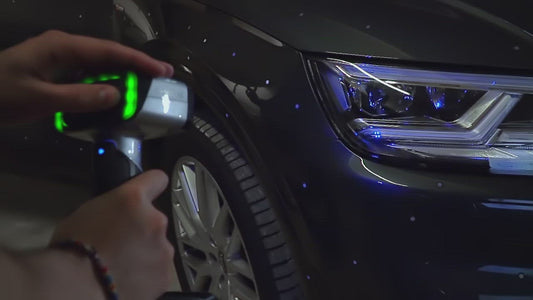Table of Contents
Whether you’re looking to reverse engineer products, ensure parts fit an assembly, or simply digitizing a model, choosing the right tool for the job is important. In this guidebook we’ll delve deeper into the technology and specifications so you know how to select the right scanner for your application!
1 - How do 3D scanners work?
2 - What are the differences between Laser and Structured Light scanners?
3 - Why should we choose: a desktop or handheld scanner?
Pt. 2
4 - What specifications should I look for when selecting a 3D scanner
5 - Common applications and workflows
What specifications should I look for when selecting a 3D scanner?
1 - Accuracy
Accuracy is the measure of how closely the 3D model matches a real object. Knowing the accuracy of your scanner is very important because it determines whether it is suitable for quality inspection, reverse engineering, medical design, or any other applications with rigid accuracy requirements. Usually, the higher accuracy the scanner is able to generate, the more applications it can be suitable for, and of course, the higher the cost. So, when you consider accuracy, you need to think about what you want to scan and what accuracy is absolutely necessary. The accuracy used in the specifications of the scanner usually refer to the accuracy of a single shot. The volumetric accuracy refers to the relationship between 3D data accuracy and object size. 3D scanners should be tested when they leave the factory floor to fit VDI/VDE 2634 standards and provide the test results to the customer. Individual users should also be able to test the accuracy of the scanner with an accuracy test in their scanner software.
The Einscan Pro handheld scanners can reach a volumetric accuracy of 0.3 mm + 0.1 mm per meter. This conclusion is obtained by measuring the center of the sphere under marker alignment shown in the images below. The volumetric accuracy of the EinScan HX scanner in laser mode is 0.04 + 0.06 mm per meter.
Einscan Pro Series Accuracy Factory Test Method
Einscan H Series Accuracy Factory Test Method
2 - Resolution
The resolution of the scanner refers to the point distance it is capturing. In a 3D model, the distance between two points is one of the most important factors. A high resolution scan has a very small point distance, making details easier to see in the scan. Subsequently, low resolution scans have wider point distances, allowing large objects to be scanned faster. The resolution can be changed before each scan to match the object and intended purpose for the data with our curated selection of scanners.
3 - Part Size / Ease of Use
Choosing the right 3D scanner for your application will depend on the size, material, and detail of the object. Answer these questions:
- What is the size of the object or objects you will be capturing?
- Will you be scanning variously sized objects? Or perhaps you are planning to automate your workflow and capture large amounts of identical objects?
- What material are your objects made out of and how detailed are they?
- Are you planning to 3D scan animate or inanimate objects?
If your workflow includes mostly scanning small objects such as keys and coins, engine valves, connectors, compressors, human ears, jaw structures, opt for a desktop scanner to capture these objects automatically with high accuracy and resolution.
For medium objects, such as furniture, people, midscale statues or motorcycles, go with a handheld scanner with fast capture and maneuver around the model to capture the data and measurements you want to collect for your application.
If your workflow includes mostly capturing large objects, such as cars, planes, or boats, opt for a handheld laser scanner, precise enough to capture those large objects in high accuracy and detail.
4 - Scan Speed
Time is money and that’s why it is very important to consider the speed of a 3D scanner.
In 3D scanning, scan speed refers to how quickly an object can be captured. This is calculated by the number of frames and the number of points captured per second. Some advanced white light 3D scanners only need one second to shoot 30 frames and capture 2 million points from the object. Laser scanners typically collect a fewer number of points but still average around 500,000 - 1 million points per second and up to 55 frames per second. We need a fast scanner for scanning people or objects that may shift or deform after a short period because 3D scanners work best on stationary objects that can keep their shape. Speed also improves work efficiency when you are going to capture large objects such as cars or many different objects in a warehouse. .
For a desktop scanner, this means how fast each shot takes and the number of points generated. The time the turntable spins for a full rotation also plays a part. For handheld scanners this refers to how many points and frames are captured which improve the efficiency of scan alignment for each second it takes to move around to scan an object.
5 - Environment
The scanning environment is yet another factor to consider when making your choice.
- What will be the standard conditions you scan in?
- Will you be scanning outdoors in direct sunlight? Or perhaps it will be in a dark and humid place?
Factors such as temperature, humidity and light can greatly affect both the overall performance of the scanner and the quality of the scans themselves.
Manufacturers will usually indicate the optimal temperature range, as well as the accepted levels of humidity for their 3D scanning solutions, but there are a few universal rules to ensuring your 3D scanner works properly and delivers accurate results.
- Scanners might overheat when exposed to extremely high temperatures. Similarly, avoid using your device in low temperatures, as a very cold environment also affects the scanner’s accuracy and may cause it to malfunction.
- As with any other electronic equipment, 3D scanners should not be exposed to high humidity or have any contact with liquids
- Keep your device away from dirt, dust and other small particles that may cause damage
- Ensure you have enough light to capture your object
- Only very few 3D scanners can capture in direct sunlight. Most will need you to create shade where possible for better results.
6 - Software
Remember that it is the software that really powers the 3D scanner. 3D scanners collect half a million to one million points per second, so you can collect copious amounts of measurement data to represent the geometry of your parts with exceptional fidelity. Reliably taking advantage of all that information requires the right scan-native software.
You’ll need to consider your use case and explore the various softwares that work with scan data, mesh files, or other 3D model formats to achieve your goal.
Now that you are familiar with the main criteria for choosing the optimal 3D scanner for your projects, you can now move on to researching the 3D scanners on the market for your application. Here at 3D Wonders, we are happy to offer a one-on-one demonstration, as well as online training, workshops, and rewards for customers who partner with us. Talk to the experts today to find out more about 3D scanning technologies and how they can have a long-lasting impact on your business.
Common applications and recommended specifications
Archeology and Conservation: Preservation of skeletal remains, artifacts, and objects of cultural heritage.
Architecture: Building scanning is used for surveying, designing, and repairing degraded exteriors.
Engineering: Tolerance tests, quality control, data analysis, full textured models, infrastructure building and monitoring.
Hobbyist 3D Printing: scanning real-world objects for reproduction using a 3D printer. Miniatures, cosplay, household items and repairs, toys, and other functional parts.
Reverse Engineering and Repairs: Automotive, aviation, naval repairs, and restoration of antique or discontinued vehicles.
Forensics: digital replicas of crime scenes to capture evidence such as shoe prints, blood stains, bullet holes, and so on.
Medical: custom orthopedics, wheelchair and mobility aids, prosthetics, plastic surgery implants, protective equipment, realistic dummies for training.
Jewelry: bespoke designs, repairs, and easy duplication/replication of damaged family heirlooms or discontinued jewelry with sentimental value.
Virtual Reality and Game Design: real-world object/landmark scanning for use in VR environments, and body scans to create realistic animations and in-game models.






